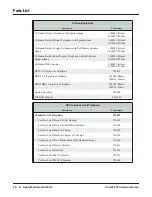
20
User Manual smar-tel-i
Oper
ati
o
n
If you are in the process of programming, it will abort as soon as someone attempts
to call you.
For every call, extensive information appears in the display about the caller or the reason for
calling.
Examples of different kinds of information about call.
If you do not operate your smar-tel-i with an AUERSWALD PBX, but rather connect it
directly to the network termination of your EURO-ISDN interface, then the MSN being
called or the text that is stored in smar-tel-i is shown in the lower display line. Termi-
nating the call with “End“ is not possible.
If you are in the process of programming, this can be finished while the telephone is
ringing after which you can pick up the receiver. By pressing the “Exit“ key, pro-
gramming is aborted and the telephone number of the caller is displayed.
4. 3. 1
Text Displays When Beeing Called
A call is initiated by an internal subscriber in the “kitchen.“
(If the subscriber is not stored in the PBX by the operator
program, a name is used that might be stored in the tele-
phone book.)
This call is a call-back that was originally activated by subs-
criber 31 or vice versa.
A call to a call group was initiated by subscriber 31.
Code call 3 was activated by an internal subscriber in the
switching centre. (The subscriber name must be stored in
the PBX by using the operator program.)
An alarm was activated on the AUERSWALD PBX. Pres-
sing the soft-key under “confirm“ confirms the call.
You receive a wake-up call. Pressing the soft-key under
“OK“ activates music on hold over the loudspeaker.
You have activated “call protection“ for your telephone.
Internal subscriber “33“ wants to reach you anyway and has
initiated an urgency call.
Kitchen
End ok
Call-Back 31
End ok
Call groups 31
End ok
Code Call 3 Sw.centr
End ok
Alarm Call
Confirm
Wake-up Call
End ok
Urgent 33
End ok
















































